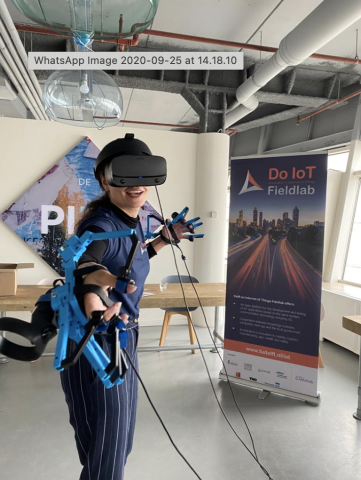Space53
We're on the eve of major changes. Robots that can fly, drive, crawl and dig make their appearance. The Netherlands has the capacity and entrepreneurial spirit to lead the development of technology for unmanned systems. Space53 fully facilitates this innovation process and provides everything that this requires.
Unmanned systems, like drones, have great potential. They can quickly and efficiently inspect bridges, viaducts, dykes and waterways much more frequently than people can. They also facilitate precision farming: monitoring crops from a great distance so the farmer only needs to use extra fertilizer or pesticides where necessary. Unmanned logistics is another development, where goods are flown from one industrial area to another. Technology and new applications are developing at lightning speed, but the strict Dutch regulations get in the way. This makes it difficult to demonstrate that a product functions in a responsible and safe way; a prerequisite for marketing the product. Living lab Space53 does offer that possibility and facilitates the entire innovation process in real-life conditions.
Approach
Space53 is located at Technology Base in Enschede, the only business park in the Netherlands with its own airport (Twente Airport). Long roads, water basins, an unprecedented long runway for very large and heavy aircraft, extensive fields, offices, technical workspaces and indoor and outdoor test sites are abundantly present. The spacious layout of the living lab allows for safe experimentation and further development. All the necessary permits are available. In addition to Technology Base, the municipality of Enschede and the University of Twente are working hard to make industrial areas, residential areas and the university campus available as real-life experimental zones.
Innovations
A large number of studies and innovations are carried out in the living lab: from drones that control traffic, flying systems with facial recognition to enormous ambulance platforms that can transport a victim. Below are a few more examples:
- Surveillance drone
The semi-automatic surveillance drone for industrial areas is self-sufficient and set up on a loading platform. In the event of an incident, the drone is activated and automatically heads to the correct location. The camera images are transmitted live to the emergency services to provide a good overview. Operators in the control room can take control of the camera for more details. A proof of concept is being developed together with the Ministry of Justice and Security. - Autonomous drone
A cluster of companies researches how a drone can be made completely autonomous so it chooses its own way, takes obstacles into account and learns from its experiences. This development is already being used in the automotive world; for unmanned flying systems, it is on the rise. - Bird drone
Drones shaped like birds of prey, for example, can quickly and cheaply track poachers and chase birds away from an airport. The testing of these drones and the training of specialised pilots take place at Space53. - Safety of the airspace
Besides the many useful applications, drones can also be misused or even abused, making them a safety risk. Together with local authorities and the safety region, the system of technological and societal measures (regulation, awareness, etc) will be examined to prevent abuse and keep the airspace safe for people on the ground. - Tracking of missing persons
Saxion University of Applied Sciences and the safety region are investigating how drones can be equipped with innovative sensors and software to find missing persons covered by rubble or buried.
Business
Start-ups and established national and international technology companies in the fields of safety and security, precision agriculture, inspection, maintenance and logistics are developing technology for unmanned systems at Space53. This is done in collaboration with emergency services such as the Twente Fire Brigade and Ambulance Oost, Twente Safety Campus, the Ministry of Defence, the municipality of Enschede, the province of Overijssel and educational and research institutions such as the University of Twente, Saxion University of Applied Sciences and ROC Twente. Individuals, public organisations and companies with ideas are invited to investigate, together with the experts from the Space53 network, whether it is possible to arrive at a feasible project proposal. To this end, we are developing a Readiness Scan.
Participation
Space53 is not only a living lab, but also an ecosystem under construction. Companies that wish to participate in this ecosystem pay an annual fee. The amount of this fee depends on the desired support and facilities, as well as on their own contribution to the ecosystem. Companies, governments and knowledge institutions from all over the country are welcome as partners.
Contact Details
Space53 Foundation
Marc Sandelowsky
Program Director
M: +31 6 24 969 269
E: marc@space53.eu














